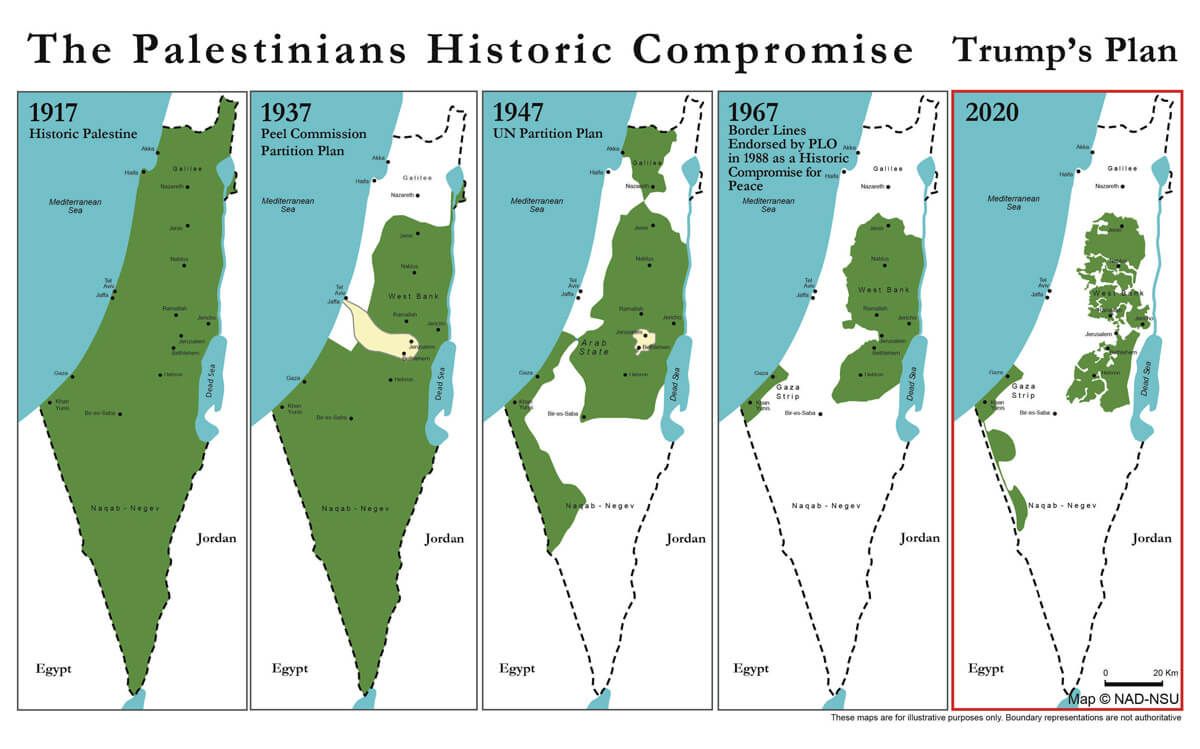If the annexation issue had a Facebook status it would be ‘complicated’. To get a complete, nuanced picture of this evolving story requires a careful attention to sometimes confusing details and an awareness of historical context. But in this era of clickbait, an evocative headline and catchy introduction can distract readers from the cold, hard facts of a story.
A case in point is a June 18 piece published in the Financial Times titled Israel’s annexation plan: the ‘existential threat’ to Palestinian Dreams. Mehul Srivastava’s analysis glitters with vivid descriptions. “At the café beside Route 90, the two-lane highway that serves as the spine of the Jordan Valley, nearly all the customers are armed.” Srivastava is clearly a gifted writer, with a keen ability to take readers on a journey filled with interesting characters, spicy dialogue, and captivating scenes.
But then the bias crept in.
Join the fight for Israel’s fair coverage in the news
Unfortunately, what started out as a colorful travel log stumbles over a series of misleading terms. While the David vs. Goliath narrative is compelling, there are a few facts about the Israel-Palestinian issue that the author missed.

“Wresting Control of the West Bank from Jordan”
Srivastava writes that Israeli Prime Minister Benjamin Netanyahu has “sent teams of mapmakers to fan out across the entirety of the West Bank, which Israel wrested from Jordanian control in the six-day war of 1967.” What the writer fails to mention is that Israel was compelled to act against Jordan. In fact, the government in Jerusalem called upon Jordan numerous times to refrain from hostilities. Instead, Jordan’s King Hussein launched multiple attacks on Israel.
“East Jerusalem”
Next, Srivastava notes: “Until recently, Israel’s unilateral annexation of East Jerusalem in 1967, and the Syrian Golan Heights in 1981, had been ignored by the international community.” Here, the writer presents ‘East Jerusalem’ as an independent political entity that the IDF grabbed during the Six-Day War. Srivastava thus implies that East Jerusalem was an Arab city, as opposed to Jewish ‘West Jerusalem’.
Sure, the Palestinians want to establish their future capital in East Jerusalem. However, the term ‘Arab East Jerusalem’ has no basis in history. Up until Jordan illegally occupied the eastern part Jerusalem in 1950 the city had never been divided.
“Non-Voting Residents”
Srivastava then describes, “East Jerusalem’s Arabs after the 1967 war, as non-voting residents of Israel who are often forced to prove their ties to the contested city or lose their coveted residency.”
Fact check: Yes, the overwhelming majority of 300,000 Palestinians living in eastern Jerusalem aren’t Israeli citizens. They’re permanent residents who have many of the rights of full-fledged citizens, such as voting in municipal elections, access to social security compensation, membership in one of Israel’s health funds and employment in virtually any profession.
Also, the writer neglects to mention that the denial of citizenship was self-inflicted. After the Six-Day War, residents of eastern Jerusalem rejected the possibility of receiving Israeli citizenship as a protest against newly established Israeli sovereignty. However, more and more Palestinians in eastern Jerusalem are applying for Israeli citizenship in hopes of swapping their vulnerable status as mere city residents for the rights and ease of travel that come with an Israeli passport.
Related reading: Do Arab Israelis Really Suffer From Apartheid?
“One-State Solution”
According to Srivastava, the pending annexation has “…also revived interest in the idea of a one-state solution, where Israelis and Palestinians have equal democratic rights, a concept that Israel’s rightwing considers the biggest threat to Zionism.”

Here’s the problem with that assertion: The one-state solution is a euphemism for the destruction of the Jewish state. It’s nothing more than a pleasant sounding bromide peddled by the most extreme rejectionist elements within the Palestinian movement and their allies. The staunchest supporters of a one-state solution are terrorist groups such as Hamas and Hezbollah.
Legacy of Peace Negotiations?
After portraying Israel as Goliath, Srivastava turns his attention to the Palestinians: “Mahmoud Abbas, the Palestinian leader, has tied his legacy to the success of peace negotiations, coming tantalizingly close with Mr. Netanyahu’s predecessor, Ehud Olmert, in 2008.”
Incitement as a matter of official government policy in territories administered by Abbas has ensured that an entire generation of Palestinians is being fed a diet of hatred towards Jews and Israel. That incitement, together with funds awarded to the families of individuals who commit terror attacks against Jews, generated a wave of stabbings and vehicular attacks in the winter of 2015-16.
“The Palestinians Historic Compromise”

Srivastava uses the image of Abbas holding a “The Palestinians Historic Compromise” map to state a fact: the Palestinian state has been disintegrating since 1917. Truth is that no Palestinian government ever controlled any territory until the Oslo Accords in the 1990s. See all those green sections on the map? Those were areas not under Israeli sovereignty: nothing more, nothing less. Indeed, the vast majority of the land claimed by Abbas as a historic Palestinian homeland actually had no legal owner following the collapse of the Ottoman Empire.
Facts Are Such Stubborn Things…
Srivastava’s piece is instructive because it’s a prime example of a good writer using emotive language at the expense of relaying cold, hard facts. Misrepresenting, or glossing over irrefutable facts, especially when it comes to the Israeli-Palestinian issue, can have a powerful impact on public perceptions. And when the end result is a story that conveys a prejudice in favor of or against one group compared with another that’s called bias.
While Mehul Srivastava is most certainly entitled to his opinions, he’s not entitled to his own facts.
Enjoyed reading this article? Follow the HonestReporting page on Facebook to read more articles debunking news bias and smears, as well as others explaining Israel’s history, politics, and international affairs. Click here to learn more!


